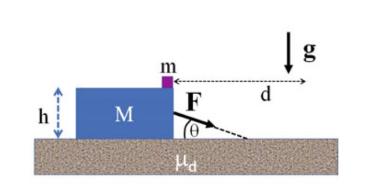Consider as in Fig. 4.14 a block of mass (M=1.35 mathrm{~kg}) placed on a rough horizontal plane
Question:
Consider as in Fig. 4.14 a block of mass \(M=1.35 \mathrm{~kg}\) placed on a rough horizontal plane with dynamic coefficient of friction \(\mu_{d}=0.250\) to which a constant force \(\mathbf{F}\) is applied. The force forms with the horizontal an angle \(\theta=40^{\circ}\), so that \(\mathbf{F}\) (of magnitude \(10.7 \mathrm{~N}\) ) has a downward directed component. Above the block \(M\) is placed an object of mass \(m=419 \mathrm{~g}\) of negligible size, which can be considered point-like. Between the material point \(m\) and the block \(M\) there is friction. Under such conditions, friction causes there to be no relative motion between the two bodies. If the two bodies are initially stationary, calculate:
1. the acceleration with which the two bodies move;
2. their speed after traveling a space \(d=6.62 \mathrm{~m}\);
3. the static frictional force exerted between the material point \(m\) and the block \(M\) and the (minimum) value of the corresponding static friction coefficient.
4. Traveled the space \(d\), the block is instantaneously stopped. At what distance \(s\) from the block does the material point fall, if the block is \(h=3.10 \mathrm{~m}\) high? Assume that the material point, placed on the edge of \(M\), does not crawl over the block before falling.
Fig. 4.14

Step by Step Answer:






